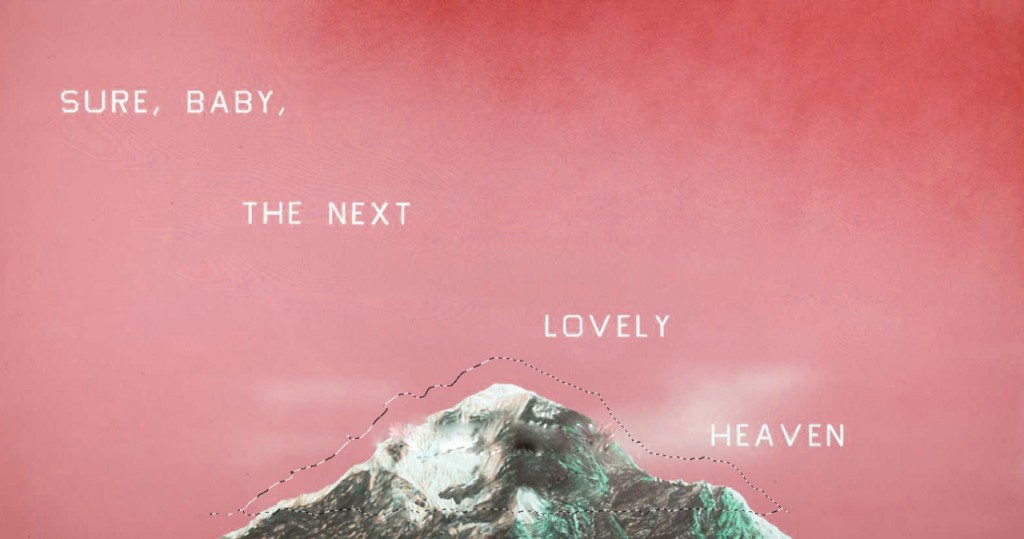by Alana Dao
Influenced by ideas of chance and Zen Buddhism, Mr. Johnson came to develop a hieroglyphic-like language in which image and word melted into each other, a language so complex it cried out not for curators but military code-breakers. Randy Kennedy, on Ray Johnson1
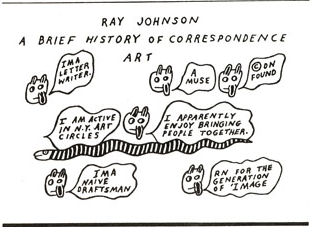
Artist correspondence, both formal and informal, has been a longstanding tradition. Mail was, for quite some time, the only mode of communication for those living far away from other artists or colleagues and became a way for artists to communicate internationally. Mail Art and the New York Correspondence School began as an off-shoot of the Fluxus movement in the 1960s and 1970s. With artists like Joseph Beuys and George Brecht creating terms such as social sculpture and participatory art, Mail Art became a form of continuous movement and represented egalitarianism.3 Johnson and his contemporaries like Beuys and Brecht were interested in incorporating active participation while creating and developing networks to create work.
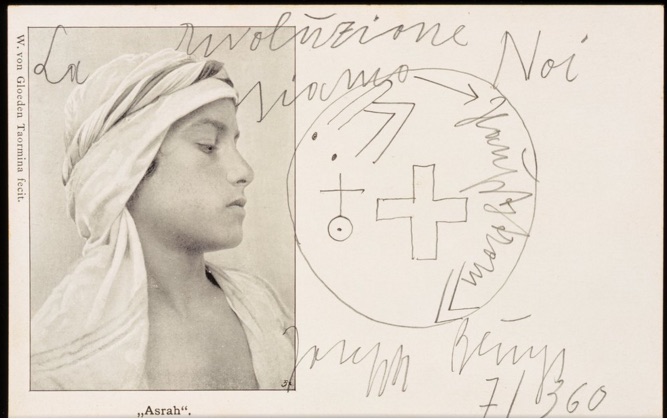
Art is a way to connect, so it seems only natural for artists to communicate with each other artistically, creating networks as they share ideas, images, and inspiration. Erased By Us, the current collaborative work of Irina Skornyakova and meg willing, draws on correspondence and mail art and how we create networks and lines of communication. Erased By Us picks up where Johnson left off, continuing the ongoing conversation of how art, correspondence, and technology reside next to and with each other, using technology to equalize and maintain accessibility and create new intimacies.
Erased By Us, at its simplest, is a mode of communication, a way to correspond. We — as viewers — are taking a peek into the conversation of two artists in two ways: the project is both an intimate exchange of ideas between two women and a public display on the Internet via Tumblr.
The project began after citydrift/Portland in Fall of 2014 in Portland, Maine. Irina was an co-curator for citydrift/Portland and invited meg to participate. meg completed a successful erasure project where participants were provided with a Sharpie and the same excerpt of James Joyce’s Ulysses to create their own erasure poems. After seeing this piece through, the two women began to conceive of a more regular practice of erasures continue the exchange of ideas they would have when they were together, geographically. They desired to keep in touch and continue the ongoing conversation they began at citydrift/Portland of what it means to create something new from the same basic materials.
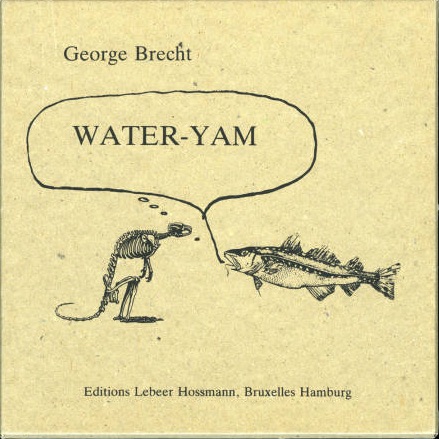
The site functions as an archival space in virtual reality and by keeping it public, viewers are able to follow along. It is a private and ongoing exchange of ideas between two artists but when it becomes public domain via the Internet, it also becomes social sculpture. It is equalizing art, providing accessibility and allowing any viewer to participate in the conversation. They can “like” it, share it on their social media, etc.
The weekly updates are a conversation between two artists that we are able to view in real time, yet their work springboards off pieces made in the past by other artists. Irina and meg create their erasures from the work of well-known artists of all mediums, from poet Pablo Neruda to painter Rene Magritte. As the past is erased and the women leave their mark on recognizable artwork, Erased By Us takes on it own life force, documenting and archiving work by meg and Irina, work of artists past, and opens up otherwise private correspondence.
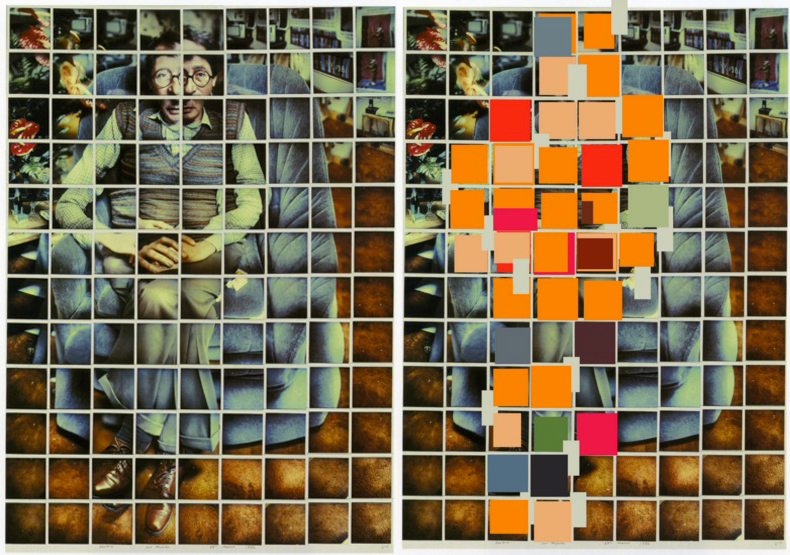
I was curious about how Erased By Us worked, who sent what, how it was decided, and how each of them worked individually. I imagined it is hard to continue with something, week after week, and wondered how they are able to do it. meg and Irina seemed to have no qualms about sticking to it, though. As they told me, one of the reason why this works is because they both work similarly. Each of them consider routine and consistency as part of their practices and this collaborative work is no different. As they described Erased By Us, I was struck by how this project seems to structure and grow on its own. It’s casual with no end or firm goal or deadline which feels liberating and true to the work.
Sitting down with meg and Irina on a chilly Saturday morning, I had the privilege to talk to them about the project, process what it means, and verbalize it with the other in front of them. This is something that doesn’t happen often, as much of the work is done remotely. meg drove down from the foothills of Maine and met up with Irina and myself in the West End of Portland. From the very beginning, it was clear that their artistic conversation would be held in a virtual space for very practical reasons because they both live in separate regions of the state. In fact, much of how Erased By Us has been formed through practicality. As image and text are cut and collaged, so are the ways they create and nurture this collaboration. The project seems to grow seamlessly and organically, qualities that seem to seep through the project’s structure and into the work itself. The few guidelines they have sprouted up through happenstance and, since they work, they’ve kept them. They are as follows:
+ Irina chooses a text, meg an image, and they each send it to the other on a Sunday. meg tells me, “From its conception we decided it would be a weekly thing. We send materials to each other on Sundays and have the week to complete the erasure. We post to Tumblr whenever we are done.”
+ Before receiving the materials via email, neither of them knows what to expect. This, to me, was quite a mischievous component. On the subject of which materials were the most challenging to work with, both artists groaned when thinking back on pieces that were particularly difficult for them. One of the pieces that kept coming up was the Neruda (pictured below). meg recalled receiving that email, opening up the image, and thinking “ohhh, Irina!” meg told the both of us, “I kept looking at it and not knowing what to do. That Neruda text was already so perfect, so rich, how could I erase or manipulate it at all?” Irina cracked up as meg was telling this story then discussed her difficulties more generally. Irina’s individual practice has long involved gray scale and geometric shapes and when meg would send her pieces focused on floral imagery or had a lot of color, it was a challenge for her. In the end, however, Irina believes this project has led to her desire to add more color to her work outside of Erased By Us. They laughed when they remembered sending these particular challenges to one another and led to talking about the mischievousness and levity to projects such as these. Irina recalled a previous correspondence she had held with another artist where she exclusively sent empty envelopes for a spell.
+ There is no hesitation as both of them delve into the materials the other has provided. While both work digitally, their styles and processes are vastly different. Irina makes “no revisions of editing. The immediacy of it is important to me.” She allows herself this one sitting to finish the piece and doesn’t look back. meg, on the other hand, works, re-works, and “if it doesn’t feel right, I go back to it.”
+ The final “result” is never shared privately, but rather through a public medium. Both artists upload their erasure to Tumblr and see it for the first time when the public does.
That last guideline made me realize the trust and belief each of them have in the other. In this process, they are honoring art past, creating new imagery, and inhabiting and influencing each other’s practice in a most intimate way. As the project has grown, meg and Irina have both individually tried to push the other with the material they send. As meg puts it, “It’s a dialogue through art. A correspondence. The pieces speak to each other; we speak through the pieces.” Each of them is pushing and pulling at each other, creating tension between the work and themselves.
Erased By Us is a collaborative work but both women maintain individual practices as well. Although this work lives in a virtual space, it is uncanny that it has guided Irina back to more “traditional” mediums. She told me, “For a long time I didn’t work with color. I had stopped painting awhile ago but have recently picked it back up again.” She believes this is due to the fact that the conversations she has with meg via Erased By Us has pushed her to work with color, bringing her back to painting. She noted that, in many ways, Erased By Us uses the same modes of thinking she uses in painting and other work. The use of adding, subtracting, and adding back again in order to create something new in an image or work of their own, for her, is at the heart of any artistic practice and Erased By Us is the same.
Collage and the act of assemblage reflect the idea of representation in the project as well. As Irina and meg both agree that this is “an ongoing conversation amongst themselves” and “transforming elements of the past to create a new present”, we are only seeing snippets of thought. The conversation is private albeit presented publicly and the viewer is interwoven into the exchange as they view the work in real time. Erased By Us cuts, assembles, and reassembles the way we understand intimacy, trust, and public/private spheres.
At the end of the meeting we decided that meg and Irina would separately contact me with three of their favorite images from Erased By Us. This ties this entire conversation together as an inadvertent play on how meg and Irina communicate and share their work. I, the writer, would receive their chosen images for publication and they will view them as the reader does, in real time. This left me with a heavy task – I became the medium, the first person to view what they chose, thus putting me into the voyeuristic position with a certain power, as though I was peeking into their intimate thoughts and communication.
As we, the viewers, catch a glimpse into artists’ correspondence, we are all creating a larger conversation around intimacy, trust, and communication. We look at this art from the privacy of our own homes rather than attending a gallery or museum. Erased By Us, as other projects in the Mail Art movement did previously, takes art out of spaces designated specifically for art and grants art accessibility and equality in audience engagement. Erased By Us allows viewers the opportunity to access art wherever they desire, thus involving and weaving the public into the private, beckoning us into their world and perhaps erasing lines drawn by our contemporary forms of communication.
‘The people in Fluxus had understood,’ as Brecht explained, that ‘concert halls, theaters, and art galleries’ were ‘mummifying.’ Instead, these artists found themselves ‘preferring streets, homes, and railway stations….’7
Irina’s favorites:

Erased By Us: Week 6
Rene Magritte, The Lovers
Irina writes: “I’ve been very monochromatic for a long time and afraid of green. Now I’m obsessed with everything floral. This one is still blocky, but since I’ve been using brighter and more colors, I have also started to use a lot more softer edged shapes, let the movement of things flow a lot more freely.”
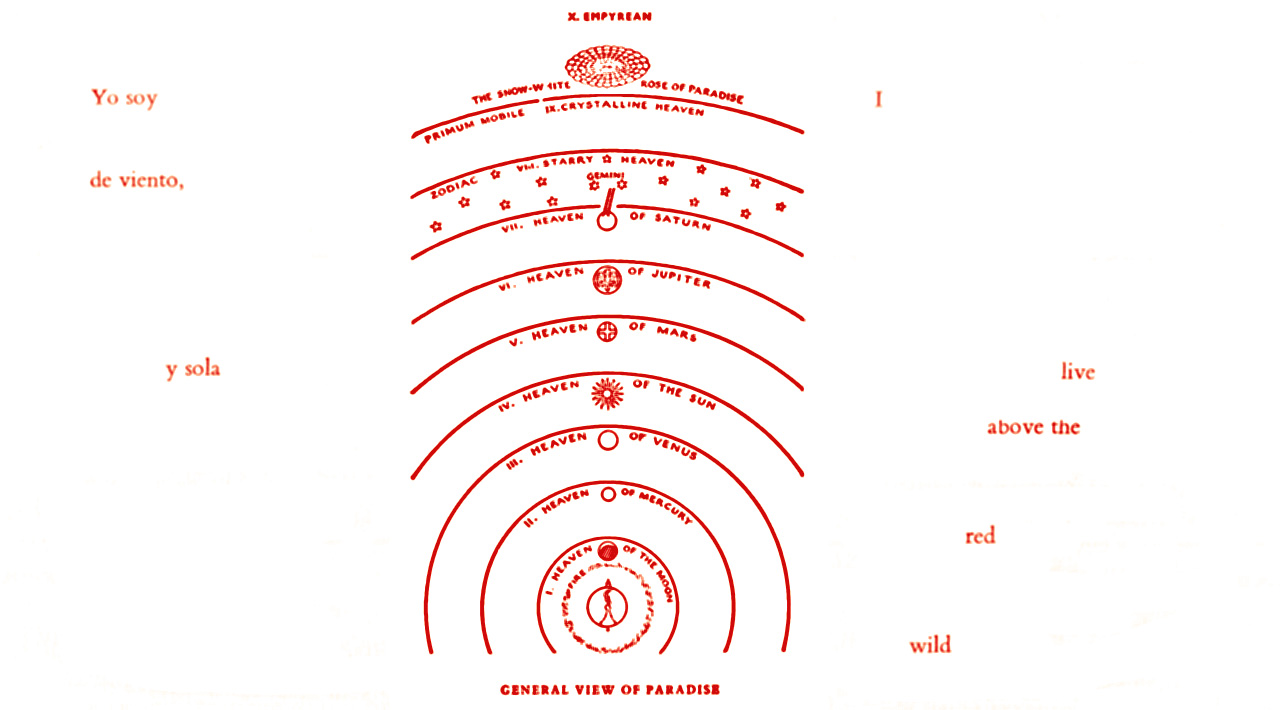
Erased By Us: Week 24
“The Condor” by Pablo Neruda from The Captain’s Verses
Irina chose this image of meg’s which we discussed together at our meeting. meg shared that this was one of the more difficult pieces she had worked with because of her deep respect for Neruda and the depth of his work. While she was explaining this, Irina smiled and admitted she had a feeling this would be the case. However, I think she believed meg would do it justice and as Irina wrote along with this image, “I really love how she made this great Neruda poem into something so open ended and expansive.”
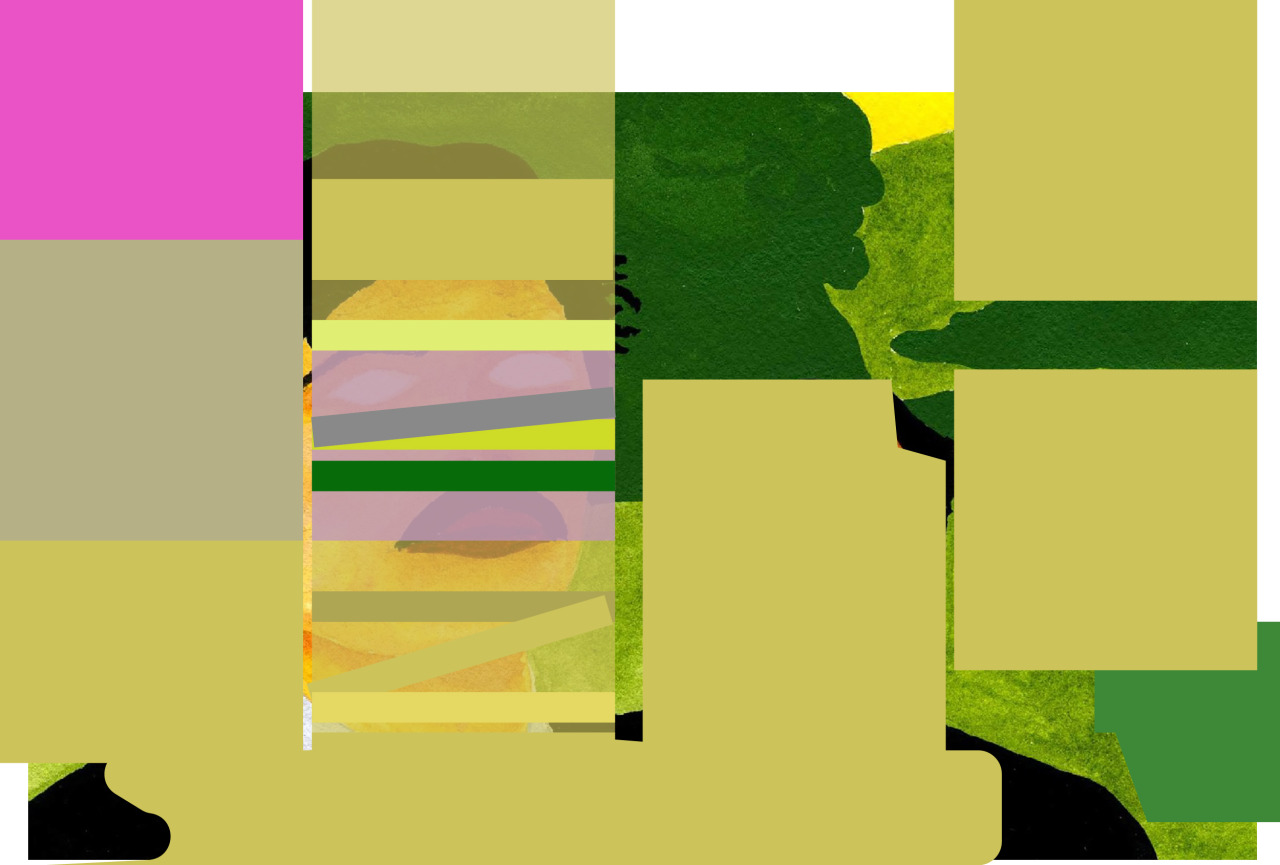
Erased By Us: Week 3
Richard Siken, One is the Dummy and One is the Voice
As mentioned above, Erased By Us has informed both artists’ work and individual studio practices. Irina chose this as an image that sticks with her because of its move away from what she had been doing in her studio up to this point. “This one because it opened up my mind to color. I’ve been very monochromatic for a long time and afraid of green. Now I’m obsessed with everything floral. This one is still blocky, but since I’ve been using brighter and more colors, I have also started to use a lot more softer edged shapes, let the movement of things flow a lot more freely.”
M
eg’s favorites:
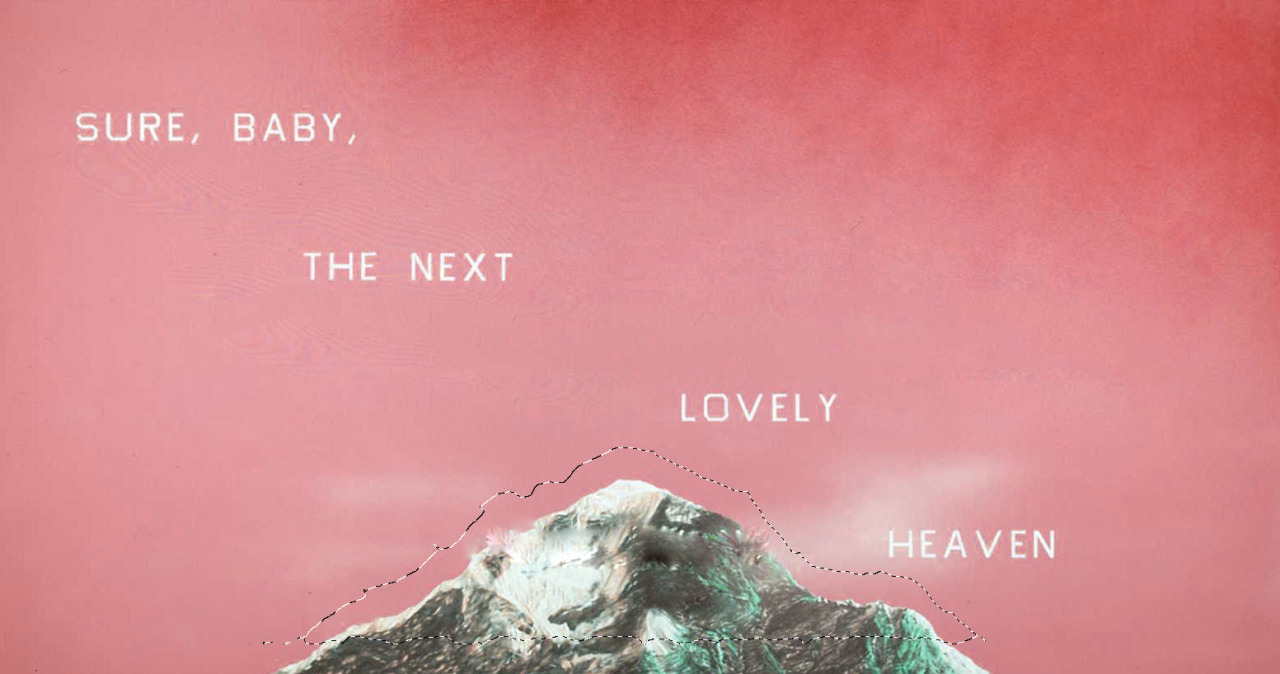
Erased By Us: Week 15
Art by Ed Ruscha from a 2011 exhibition at the Hammer Museum
This exhibition, organized by Hammer chief curator Douglas Fogle, brings together two great visionaries of art and language — Ed Ruscha and Jack Kerouac. Both men revolutionized the transparent use of words to document and comment on the shifting character of the American cultural landscape. meg writes: “I usually handpick the images I collage into my erasures, so it was a treat to work with a piece that already included both Ed Ruscha’s art and Jack Kerouac’s language. In some ways, I think of this as an American Dream piece — the speaker resigned to their love’s desire to keep searching, keep striving, for something lovelier than what’s happening right now. This cultural go-go-go condition. But, at the same time, the word ‘next’ and Kerouac’s easy tone do so much work: implying that there are many heavens and we’re probably in one right now. The sky that was originally midday blue is now sunrise pink. A full day ahead. I manipulated this image digitally and took a screen shot that included the dotted outline from the selection tool around the mountain top — everything can be transformed! (I’d actually love to make this into a gif with the selection line still blinking.) Starting points like this piece — where the material is so rich — opens the door to so many possibilities, offering me a newfound appreciation for the original work.”
[Author’s note: This is, by far, my personal favorite and I was excited to see it chosen! The colors with the white text do something for me and while the erasure of text creates something new, I feel like it still holds true and honors the original work. Ruscha’s wordplay and Kerouac’s writing are still apparent while meg and Irina create something new. The language, so reminiscent of “American” vernacular and California cool hold while it is still very much part of the Erased By Us oeuvre.]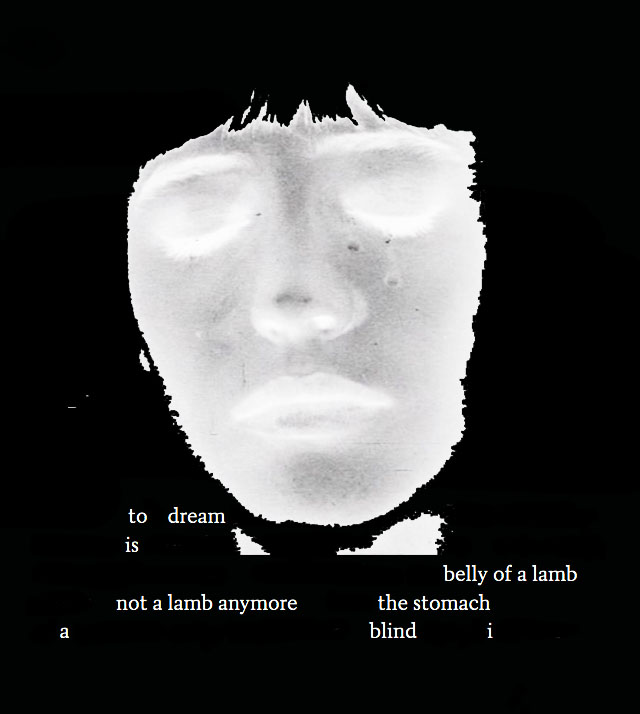
Erased by Us: Week 14
“Imaginary June” by C.D. Wright
meg chose this image as she thinks about the act of erasure: “Erasure is a process of disassociating or liberating words from a preexisting syntax. When Irina sends me a piece of writing I find resonant — like this C.D. Wright poem — it takes a lot of willpower to stop myself from doing a close read right off the bat. (If I do, I’ll get swept away in the currents of craft and the desire for erasure will go right out the window.) So I skim the text and certain words begin to shimmer, to shine through. In my solitary writing and visual art practice, I’ve been exploring the themes of memory, the subconscious, and dream/trace states; naturally, that was the language that started to radiate. Here, darkness laps the sides of the face, a woman back-floating in a body of water. Large bodies of water, in dreams, representing the subconscious. The language is also fluid, as it struggles to define. What is the difference between ‘belly’ and ‘stomach’? What is the difference between ‘eye’ and ‘i’?”
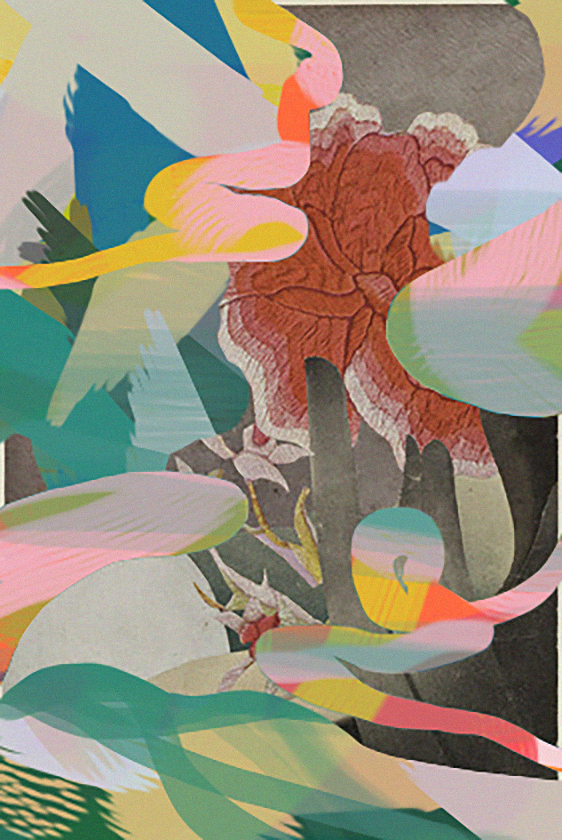
Erased By Us: Week 24
Hannah Hoch, Watched
meg’s favorite of Irina’s is this erasure worked off of Hannah Hoch’s piece, Watched. The challenge for Irina to work with more color and shape is apparent in this piece. As stated before, Erased By Us has informed the artists’ other work and they are better for it. meg chose this piece of Irina’s “because (1) it’s beautiful and (2) I was absolutely surprised when I saw it. Like birthday-party, confetti falling, friends-jumping-from-behind-the-couch-to-yell-surprise surprised. A departure from her monochromatic blocks, I was captivated by her use of color and organic curvature. She plays with opacity to layer elements seamlessly on top of each other. There’s a sense of levity in the color palette, a playfulness, a whimsy. Compositionally, I feel like I’m being invited down a winding path into a new world.”
Erased by Us is updated weekly. To see more of Irina and meg’s individual work, check out their websites: http://irinaskornyakova.net/ and http://www.megwilling.com/
- A quote from the New York Times obituary for Ray Johnson, one of the founders of correspondence art, leaned on collage as medium with correspondence being his means of distribution. Kennedy, Randy. “Always on His Own Terms.” Accessed February 8, 2016. ↩
- “A Brief History of Correspondence Art” by Ray Johnson.” Accessed February 8, 2016 ↩
- Ferranto, Matt. “Moticos to Mail Art: A History.” http://www.spareroom.org/mailart/mis_2.html Accessed 25 February 2016. ↩
- Beuys, Joseph. Asrah, 7/360, The Walker Art Center. http://www.walkerart.org/collections/artworks/asrah-from-the-von-gloeden-postcards-series Accessed Febraury 20, 2016. ↩
- Brecht, George. Water Yam, Cardboard box with 101 event cards. Joan Flasch Artists’ Book Collection. http://digital-libraries.saic.edu/cdm/singleitem/collection/jfabc/id/2102/rec/1 Accessed February 20, 2016. ↩
- Brecht, George. Water Yam, Cardboard box with 101 event cards. Joan Flasch Artists’ Book Collection. http://digital-libraries.saic.edu/cdm/singleitem/collection/jfabc/id/2102/rec/1 Accessed February 20, 2016. ↩
- Brecht, George, Julia Robinson and Alfred M. Fischer. “A Heterospective”, Berlin: Verlag der Buchhandlung Walther Konig. 29 November 2005 ↩
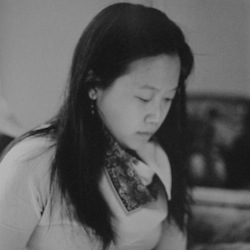
Alana Dao is a writer and maker residing in Portland, Maine with her husband and young daughter. She received a MA in Visual and Critical Studies from the School of the Art Institute of Chicago and a BA in Spanish and Latin American Studies from Smith College. She is currently a contributing writer for the online publication Dilettante Army and the Co-Founder/Executive Director of CSArt Maine, the first community art share program in the state.

